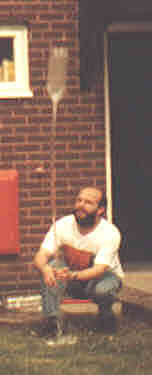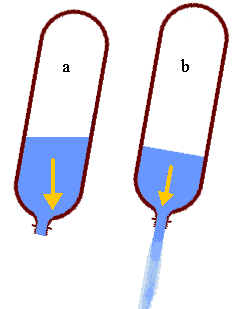These are photographs taken by my daughter of me launching a 2 litre bottle (bottle only - no fins) showing just how little you need to perform a launch. Remember folks, take precautions to mimimise any damage and keep well away from people, houses and other property that may be damaged when half a kilo of water in a plastic bottle hits it at 150 mph (I have never worked out the point at which it would have maximum momentum).
This is actually three launches from our front garden (the theory being that it is easier to retrieve the bottles from front gardens as there are no gates where we live). As you can see, it is possible to launch manually without getting too wet. The last one went over the house and into next-door-but-one's back garden - a horizontal flight of around 30 m reaching an altitude of I don't know what (imagine how far it would have gone if it had fins) - its funny how everything seems to happen in slow motion. (I haven't been able to work out why I left the front door open - I must have been feeling confident). Although it only appears in
a minority of launches, the kink in the water has
been the subject of some discussion with theories
including meta or astable flight and a wave Any instability during thrust phase is likely to cause the rocket to veer off to one side without returning to its original path whereas vortex shedding would appear continuously all of the way up with a standard wavelength. It has been noticed on static launches as well as hand held launches therefore this, to some extent, discounts the theory that it is caused by a movement just before the release (although this can happen and will have this effect). It has been noticed on launches at an angle on both static and hand held launches and that observation leads to this theory: When held at an angle (a), the propellant on one side will be deeper than on the other side (measured parallel to the axis of the rocket) as gravity is the predominant acceleration force and the surface ends up in a plane perpendicular to the axis of acceleration. When the rocket is released (b), it accelerates, forcing the surface to adopt a new plane, again perpendicular to the axis of the predominant acceleration which is the now axis of the bottle. This forces what has become a wave to propagate across the surface with respect to its new 'down' - the shift in centre of gravity resulting from this wave making the bottle wobble slightly and giving a kink in the water. Thanks to (in alphabetical order) Kimberly Brooks, Scott Chesnut, Clifford Heath, Gary Jones, Patrick Matthews and Dave Oliff for contributions in this discussion. |
||||||||||||||||||||||
|
||||||||||||||||||||||



 inside
the body of the rocket.
inside
the body of the rocket.